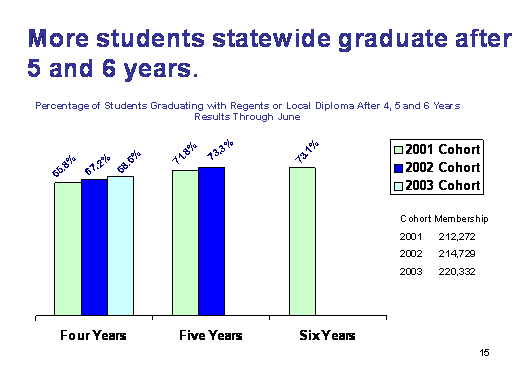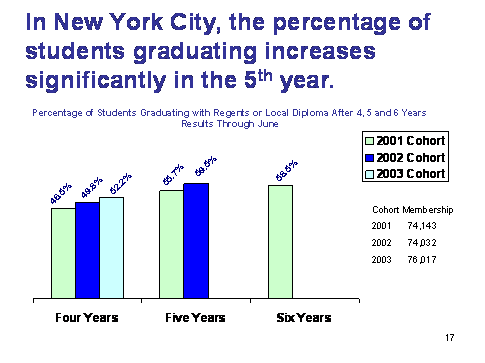Meeting of the Board of Regents | April 2009
|
|
THE STATE EDUCATION DEPARTMENT / THE UNIVERSITY OF THE STATE OF NEW YORK / ALBANY, NY 12234 |
|
TO: |
|
|
FROM: |
Johanna Duncan-Poitier |
|
SUBJECT: |
Update on United States Department of Education’s Graduation Rate Regulations – Consideration of an Extended-Year Graduation Rate
|
|
DATE: |
April 15, 2009 |
|
STRATEGIC GOAL: |
Goals 1 and 2
|
|
AUTHORIZATION(S): |
|
SUMMARY
Issue for Discussion
What actions should the Board of Regents take in regard to new regulations on high school graduation, recently announced by the United States Education Department (USED)? Do the Regents want to use an extended-year graduation rate in addition to the four-year graduation rate? Is there additional information that the Regents want to inform their policy decision on using an extended-year graduation rate?
Reason(s) for Consideration
For information.
Proposed Handling
The question will come before the EMSC Committee for discussion in April 2009.
Procedural History
In late October 2008, USED announced new regulations related to high school graduation. In March, Secretary of Education Arne Duncan announced that he supported the new regulations and would not repeal or modify them at this time.
These final regulations are intended to create a graduation rate that:
- Is accurate and ensures that students who drop out are not counted as “transfers”;
- Is comparable across states;
- Gives credit for students who take longer than four years to graduate;
- Ensures that states set an aggressive graduation rate goal and annual targets; and
- Holds schools accountable for improving graduation rates for all students and student accountability groups.
Each state must submit a revised “Consolidated State Application Accountability Workbook” for peer review in time for any changes to be in effect for AYP determinations based on assessment results from school year 2009-10. To meet this timeline, several policy decisions by the Regents are needed during the 2009 calendar year.
Background Information
The Board of Regents has paid special attention to policy decisions that will help close the achievement gap and raise graduation rates for students across New York State. The new Federal regulations provide another opportunity for the Regents to consider policy decisions in this critical area.
The new graduation rate regulations in general require that states must decide:
- A graduation rate goal, for all students and for disaggregated groups of students, including racial/ethnic groups, low-income students, students with disabilities, and English Language Learners. States must also establish targets for how much annual increase should occur for those groups of students in a school or district who are not graduating in percentages that meet the State’s graduation goal This goal and these targets will be used for accountability decisions regarding Annual Yearly Progress.
- Whether to use an extended, five or six-year graduation rate, in addition to a four-year graduation rate.
We propose that the Regents consider the graduation rate goal and graduation rate targets later this spring. This month, we propose that the Regents consider whether to use an extended year graduation rate.
Extended-Year Cohort Graduation Rates
The Federal regulations say that a state may propose for approval (by USED) an extended-year adjusted cohort graduation rate (or rates). If a state uses an extended-year graduation rate, the state must have approved how that rate will be used along with its four-year graduation rate to determine whether schools and LEAs have made AYP.
An extended-year cohort might, for example, be a five- or six-year graduation rate. The number of students in the denominators for a four-year and a five-year graduation rate at a school may differ because the extended graduation rate must account for students who enter or leave a school during the extended graduation rate period. States must have USED approve their methodology for making AYP based upon combining the four-year graduation rate and any extended-year graduation rates.
The possible advantages and disadvantages of adopting an extended-year graduation rate are:
Advantages:
- For some students, such as late arriving English language learners, certain students with disabilities, and transfer students, graduating in four years is difficult, if not impossible. Yet many more students can and do graduate in five or six years.
- An extended-year graduation rate enables schools and districts to receive credit for students who graduated within the extended time period even if students did not graduate in four years.
- As a result, schools and districts are rewarded for their efforts to ensure these students graduate, and some schools may feel less reluctant to enroll such students or seek to encourage them to transfer to other schools.
Graduation rate data that show the potential effect of an extended-year graduation rate are included as Attachment A.
Disadvantages:
- Since the state must set a single graduation rate goal, the establishment of an extended cohort essentially means success is now measured against graduation by the end of the extended time period rather than in four years.
- The extended cohort requires the collection and verification of added data points, which increases complexity and the possibility of error.
- Under the extended graduation rate definition, the school or district that educated the student for the first four years of high school may not be the school or district to which the student is attributed in the extended graduation cohort. In some cases this fact may have unintended accountability consequences.
Recommendation
The Regents should discuss whether or not they want to use an extended-year graduation rate and identify any additional information they need to inform their policy decision.
Timetable for Implementation
Staff will come back to the Regents with any additional information requested on using an extended-year graduation rate and draft a proposed policy for the Regents to consider. In future months, staff will provide the Regents with additional information on the other policy decisions the Regents need to make in 2009 based on the new Federal requirements,
Attachment A











